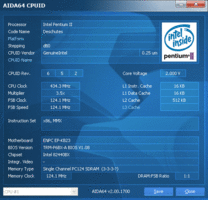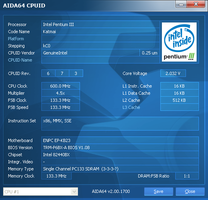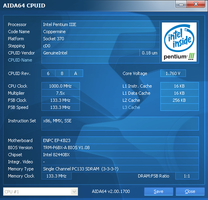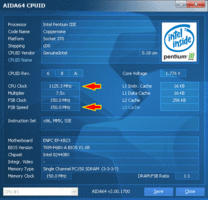I had a bunch of P2B, P2B-F, and P3B-F boards at one time. I sold most of them off. I wanted to keep 2 of them, so I tested the P2B-F and P3B-F boards for their overclocking. The winners were both P2B-Fs. That's maybe just luck of the draw but that's how it ended up for me.
My desktop 2 PCs ago was a P2B-F, 4x PC133 CL2 256MB Micron memory modules, Geforce4 Ti4200 128MB, P3-600E cB0 stepping at 800/133, an ATI video capture card, and of course a Sound Blaster AWE32. 😀 It was a good system.
I built a similar setup for a relative using a Geforce2 MX, same CPU type, RAM and overclock. Both tested stable at 840/140.
I filled in missing capacitors and replaced the chipset heatsinks with larger ones, but I don't think that really did much.
First thing you want to check is whether your board supports Coppermine voltages. You can tell that by checking the part number on the VRM chip, which is somewhere between the CPU slot and the peripheral ports. It's about 20 pins or so. If you don't know how to look up the info, post the part number here and you can get an answer.
If it's voltage compatible, then you just need to update the BIOS and you're good.
I wouldn't go over 100FSB without a heatsink on the chipset.
Some P2B board revisions had their FSB jumpers marked badly, but I don't remember what version that was. The problem was they marked how to get 133FSB with a 1/3 PCI ratio - so PCI ran at 44MHz. To get a 1/4 ratio requires a different jumper arrangement which wasn't marked on some boards. *most* are marked correctly though.
Remember that the AGP ratio is controlled by another jumper - make sure it's set to 2/3 if you run 100-133FSB.
89MHz AGP was 100% completely reliable for me with a Geforce2 MX, Geforce3 (different motherboard), and a Geforce4 Ti4200 - all 3 of those were in use at 89MHz simultaneously for 1-3 years on different BX machines. I've read that it can sometimes be a problem on some TI4xxxx cards, but mine never had a hint of trouble.
I've read that ATI cards of the time period were more problematic, but I never tried. nVidia FX5000 and later cards also reportedly don't like it.
I think ATI Radeon 8500 was known for handling 89MHz well, but like I said I never had an ATI on these.
You aren't guaranteed to hit 133FSB - some only pass stress testing at 124MHz reliably. Some can do it at 140MHz, maybe more, those are the boards I used for 133 operation. It just depends how lucky you are with your particular board. Later boards generally get faster.
Most brand-name PC100 CL2 memory is actually populated with 133CL3 RAM chips. I've even seen some that had PC133CL2 chips on them, but that's rare. Mostly just early or cheap PC100 modules are truly PC100 only (marked 8ns).
256MB modules need to have the right chip type (16Mx8) to be compatible, but the speed doesn't matter. PC133 itself doesn't make them incompatible, it's just that PC133 modules frequently don't have the right chip type so you have to be careful. I can explain in another post if you need more info.
These boards have trouble POSTing with a full 1GB of unbuffered PC133 memory. Intel wanted you to use registered memory with that amount. When I used 1GB PC133 CL2 on a P2B-F, I found that I needed to reset a few times until I saw the full 1GB appear at POST. Whatever RAM it saw at POST, was completely stable in operation - it was just a POSTing issue. This was the only nuisance I had with the machine.
Dropping to PC100, or removing 1 module, would eliminate the problem. I added some capacitors at empty spots on the board, and it seemed to help the POST only slightly, but it was far from a fix.
My favorite 440BX board for overclocking is probably the ABit BX133-RAID. It seems to be rare though, and I think every single one of them died of bad capacitors except those few that were recapped. But it's a socket-370, not a slot, and it only has 3 DIMM slots. It's a classic example of an ABit overclocking board, at a time when hotrodding the 440BX really made sense vs the chipsets that were meant to replace it. This was the board I put a Geforce3 on.
I think the BE6-II-RAID is very similar, but in Slot-1 format, and it's more common.



